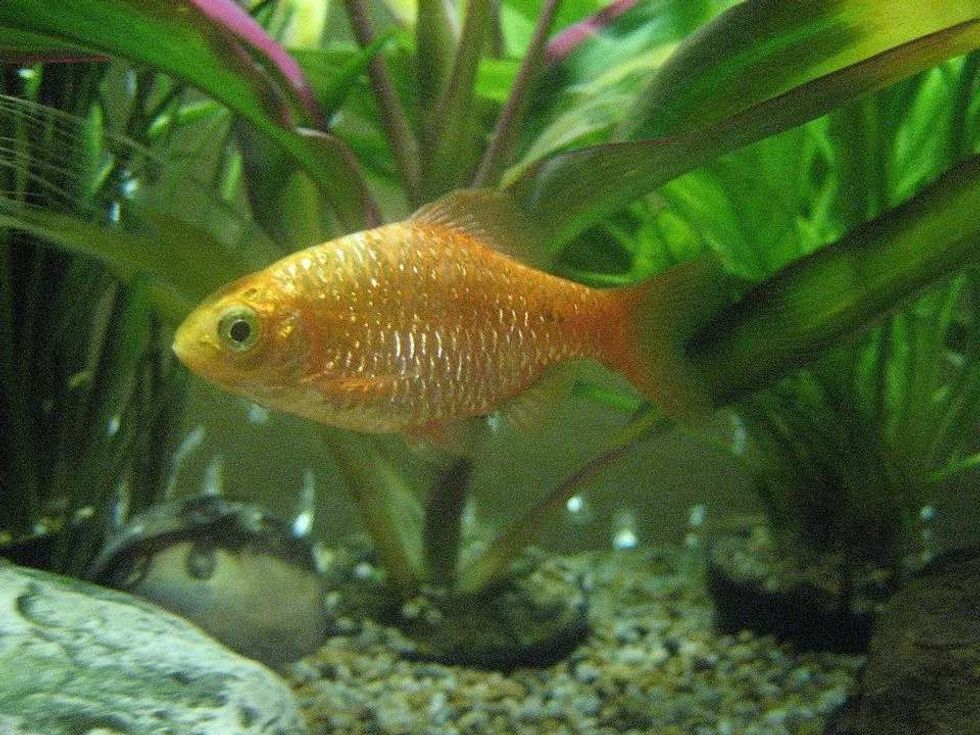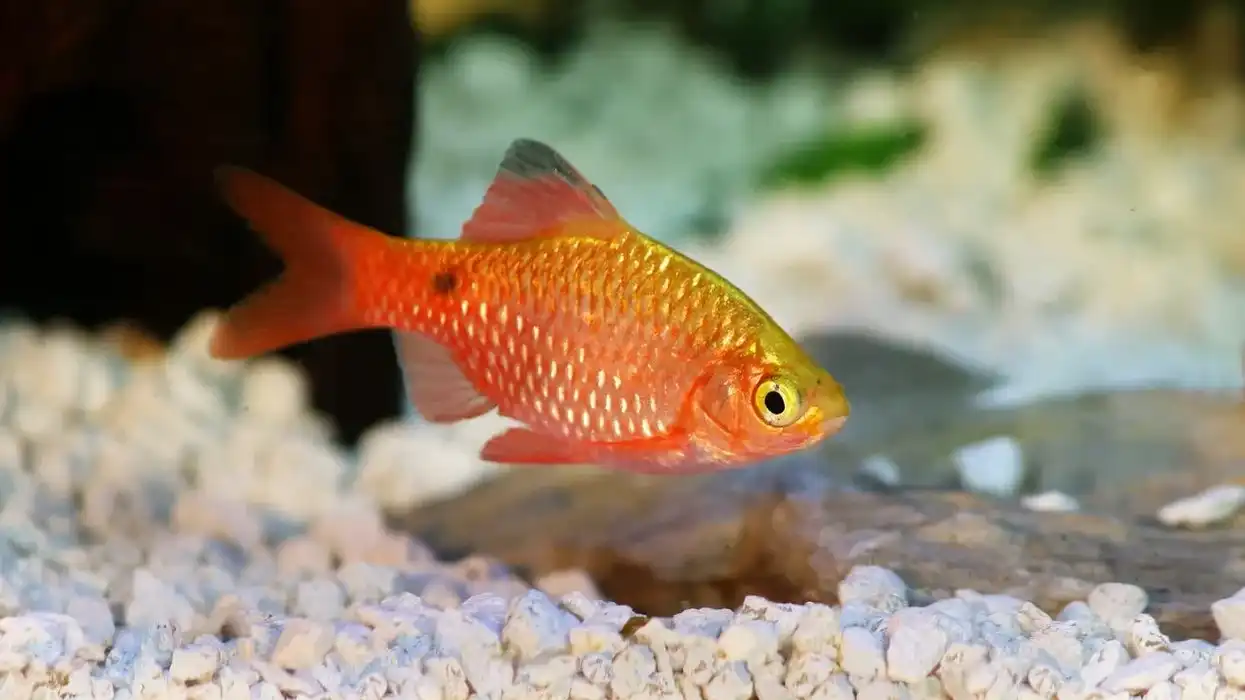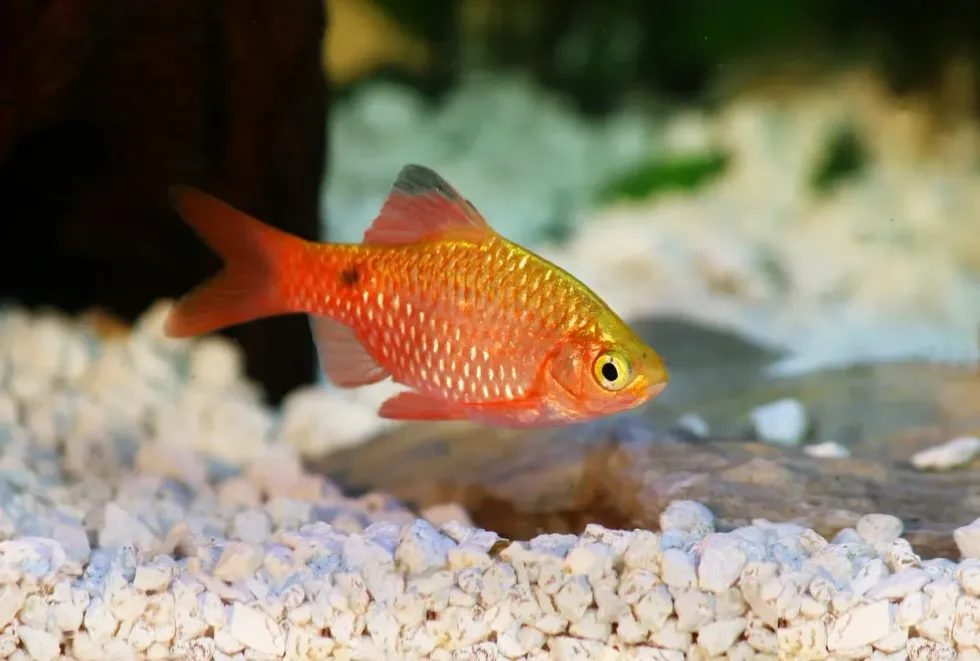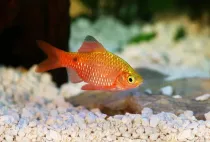Fun Rosy Barb Facts For Kids
Content
- What type of animal is a rosy barb?
- What class of animal does a rosy barb belong to?
- How many rosy barbs are there in the world?
- Where does a rosy barb live?
- What is a rosy barb's habitat?
- Who do rosy barbs live with?
- How long does a rosy barb live?
- How do they reproduce?
- What is their conservation status?
- What do rosy barbs look like?
- How cute are they?
- How do they communicate?
- How big is a rosy barb?
- How fast can a rosy barb swim?
- How much does a rosy barb weigh?
- What are the male and female names of the species?
- What would you call a baby rosy barb?
- What do they eat?
- Are they aggressive?
- Would they make a good pet?
- Did you know...
- Are rosy barbs fin-nippers?
- What is the smallest tank size you should keep rosy barbs in?
The Rosy barb, also known by the common names Pethia conchonius or Puntius conchonius, is a tropical fish species that are very common in southern Asian countries. These fish are very tiny and small in size, being only 6 in (14 cm) in length and about 12 oz (340 g) in weight.
Rosy barbs are a magnificent fish species with a slender and torpedo-shaped body and a little forked tail.
The fish species are very easy to care for as they do not show aggressive behavior and are very peaceful towards their tank mates. Because of their calm and peaceful habits, these fishes are easily kept in the community aquarium with different fishes.
They can be maintained with any kind of small fish species except try to avoid the long-finned fish so that you don't have to witness the fin nipping behavior in your fishes.
Rosy barbs are very famous for their color-changing habits as these fishes, both male and female, change their color during the breeding period. Male rosy barbs will change their color from silver to attractive red and golden, while female rosy barb looks more bright and luminous in color.
Their change in color tells the owners about their breeding period, and soon they will give birth.
Here on our page, we have lots of amazing facts about the rosy barb that everyone will enjoy. Let's look at these interesting facts; if you like these, do read our horn shark and spinner dolphin facts.
Rosy Barb Interesting Facts
What type of animal is a rosy barb?
Rosy barbs are small, tiny, and beautiful fishes that belong to the minnow family fish species. This type of fish is one of the hardiest barbs that are attractive and impressive in their own way. As the name suggests, rosy barb or red barb is found in a different mixture of silver, golden, and rosy red colors.
What class of animal does a rosy barb belong to?
Rosy barbs are a species of small fishes which belong to the class of Actinopterygii fishes. These fishes also have subspecies, including the neon-colored rosy barb, red glass rosy barb, longfin rosy barb, and gold neon rosy barb.
How many rosy barbs are there in the world?
Rosy barbs are very common fishes in South Asian countries and are found nearly everywhere, in freshwater lakes, community aquariums, and kept as pets. For this reason, the exact population of these fishes is hard to estimate as they can be in thousands and millions.
Where does a rosy barb live?
Rosy barbs are freshwater fish that are very common in the countries of South Asia. They are commonly found in the countries like India, Singapore, Australia, Mexico, Puerto Rico, and country of Colombia.
What is a rosy barb's habitat?
The Red barb species inhabit the flowing freshwater bodies like ponds, lakes, and streams. These species are prevalent to keep in the aquarium as they are peaceful and not aggressive. These fishes are also easy to care for and are seen adopting fin nipping behavior only when the large fishes are kept in the same rosy barb tank.
Who do rosy barbs live with?
Rosy barbs are tiny, beautiful, and attractive fish as they have splendid golden and red color tones. Due to the size of the rosy barb, this fish cannot be put with larger fishes in the same tank as they will start to nip each other dorsal fin.
They can be put with the small size fishes and with the same kind. Usually, the rosy barb goldfish is found and kept in a group of five fishes of the same type, where one male has two female golden rosy barbs.
How long does a rosy barb live?
A rosy barb can live up to five to six years of age in the wild, and they can also live more than that if they are well cared for and do not catch any diseases.
The Rosy barb fish is kept as a pet in an aquarium with good water conditions and water hardness because of the excellent lifespan.
How do they reproduce?
When the female of this species is prepared for breeding, they will seem swollen with eggs or pregnant. Since they are not livebearing fish, they are technically not pregnant but only gravid, with eggs inside.
The lower underbelly of the fish will be visibly swollen. The adult males will circle and chase the females, nudging her head and stomach area repeatedly.
Breeding of the rosy barb usually occurs in the early morning and lasts numerous hours, ensuing in multiple hundred eggs. Rosy barb eggs are typically deposited amongst plants, and the pair will try to devour any food they're capable of locating.
The eggs take around 24-36 hours to hatch in their habitat, relying on the water conditions and temperature range. A day later, these younger freshwater fish will grasp at the plants and/or the edges of the tank if the breeding takes vicinity in an aquarium or a breeding tank.
In approximately six days, the babies are free-swimming and will be searching for food. In captivity, they may be fed newly hatched brine shrimp.
The Rosy barb was successfully crossed with the tiger barb (Puntius tetrazona) by combining a female tiger barb with a male rosy barb. The hybrids are mature and are all males but sterile.
What is their conservation status?
Rosy barbs are categorized as Least Concern by the IUCN Red List, meaning that they will not be endangered anytime soon.
They do not require any conserving as they are large in number and are constantly breeding, be it in the open water or the aquarium, and lay a large number of eggs, around 250 eggs at a time which are to be taken care of for 48-72 hours.
Rosy Barb Fun Facts
What do rosy barbs look like?
Rosy barbs are the small and golden-pinkish color fish species that are a little plump in size with the forked tail and the greenish cast on their back. These fishes have only one dorsal fin, and the other one, which is the adipose fins, is lacking.
The males are different as they are brighter in color, and they have black color on their fins, while the females do not have any color besides golden on their fins.
The adult rosy barb can reach up to 6 in (15.24 cm) in length if they are wild, while 4 in (10.16 cm) when they are in an aquarium. The shape and size of rosy barb differ if they are from different regions.
Green rosy barb is also found in some states like West Bengal as they appear green because of their intense color and reflective scales.

How cute are they?
Rosy barbs are the beautiful, cute, and attractive fish among the whole species of fishes. This group of fish is famous for their color-changing pattern as their habit is to change color during the breeding season, and they look more attractive and bright.
This group of fishes seems very different, beautiful, and unique in the breeding tank because of their habit. The other reason is that these fishes are very peaceful and do not show any aggressive behavior, which is why people keep them as a pet.
How do they communicate?
There are no unique methods of communication done by rosy barbs. Like the other fish species, they communicate with each other through the vibration produced by their bladders.
They also communicate through the sense of smell as every other fish has different scents. The additional feature that these fishes show is that their color changes when they want to breed; this is the form of communication that tells them that they are ready to mate.
How big is a rosy barb?
The size that rosy barbs can grow is up to 6 in (15.24 cm) long.
Rosy barbs are the small and tiny fishes that can stay in any size of the aquarium, but usually, the rosy barb tank is up to the size of 30 gal (113.5 l) as this tank size is perfect for them because here the fishes can explore and have more space for the group.
How fast can a rosy barb swim?
The average range of speed that rosy barbs can swim is not estimated yet by scientists. But it is said that these species of fishes can swim at a high-speed range.
Although rosy barbs are small and tiny, they are very notorious and fast swimmers, and when they get used to the surroundings, they start chasing other rosy barb tank mates flowing tails.
How much does a rosy barb weigh?
The weight is depending upon the size and shape of the rosy barbs. But the average weight of the adult fish is around 12 oz (340 g).
What are the male and female names of the species?
The adult does not have a specific name for the females and males. They are referred to as male rosy barb and female rosy barb.
But it is easy to identify the pair of species of rosy barbs as the males have bright color than the females, and they also have a black color lining on their fins while the female fins are in their usual body color.
What would you call a baby rosy barb?
A baby rosy barb fish is referred to as fry when they are young.
When a female rosy barb lays her eggs, the parents do not show any kind of parental behavior towards the fry; but instead, they try to eat the eggs before they hatch.
So it is better if you have rosy barb as a pet in your aquarium to keep the parents away from fry after being laid by the females.
Try to provide them another aquarium without tank mates so that after 24 hours, when the eggs hatch, there is enough space for the fry to grow accordingly and without any predators.
What do they eat?
Rosy barbs are omnivores, so their diet consists of both animals and plants. Wild rosy barbs have a protein-rich diet and eat foods like worms, crustaceans, marine insects, and various plants.
But if you have your pet, the golden neon rosy barb care is effortless as the food you can give them is fry fish food and the plants' based foods.
Are they aggressive?
Rosy barbs are tiny in size, approx 6 in (15 cm) long fish. These fish are very peaceful and avoid aggressive behavior.
Although they are not aggressive, sometimes, if kept in an aquarium without school and groups and with the slower and larger fish, you will witness the rosy barb's nipper behavior with the giant fish and with the large tail fish to be different, as these notorious fish love to play with the long tails of other fish.
They are comfortable with similar fish that are non-aggressive and enjoy a cooler water temperature, including fish like danios, rope fish, and knife fish.
Fish like the golden rosy barb and tiger barb tend to hurt guppies and get aggressive towards them. They do not eat them, but they cause them fatal injuries and infections.
Would they make a good pet?
Yes, rosy barbs are excellent pets as rosy barb care is effortless, and they are peaceful and calm fish to be kept in the community aquarium. These fishes are very social and can interact easily with the other smaller fishes, and as they constantly move, your aquarium will always be lively.
All this fish needs is food, suitable temperature, and hardness water to avoid a rosy barb infection; then, they are just good to go. Make sure to keep five rosy barbs together to ensure they are happy.
Do not keep them alone. When you take good care, rosy barbs are the happiest pet ever.
Did you know...
The natural habitat that rosy barbs prefer to live in is the water temperature of six to eight pH and the hardness of 5-19 pH with the range of 64–72 °F, which is 18–22 °C.
Breeding the rosy barb is moderately easy. Keep two females and one male in a medium-sized tank with water that is a few inches deep. Select fish that has good markings and a prominent color. Keep a lot of aquatic plants to allow them privacy and a place to lay their eggs.
These fishes have a great memory. Their exact memory span is not known.
Are rosy barbs fin-nippers?
Yes, the rosy barb is the notorious fish who performs fin nipping habits. Although they are peaceful fish, they also show the tendency to get aggressive by doing fin nipping.
To take care of rosy barb, try to keep them in school and community, so as not to establish the fin nipping habit. Also, avoid keeping the long-finned and slow-moving fish like angelfish and betta fish with them as they will see their long tails and fins and try to perform their notorious tendency.
What is the smallest tank size you should keep rosy barbs in?
Rosy barbs are small and tiny fishes that are easy to take care and to keep them as a pet. They can be kept in small tanks as well as large tanks.
But try putting them in above 20 gal size (75.5 l) tanks. Although these are small and tiny fishes, they require an excessive amount of space and the correct temperature water. It is better to keep them in a 30 in long (76 cm) tank as a minimum.
Here at Kidadl, we have carefully created lots of interesting family-friendly animal facts for everyone to discover! Learn more about some other facts from our lungfish facts or cownose ray facts pages.
You can even occupy yourself at home by coloring in one of our free printable barb coloring pages.
We Want Your Photos!
More for You
See All
Bachelor of Commerce specializing in Accounting and Finance, Master of Business Administration

Divya RaghavBachelor of Commerce specializing in Accounting and Finance, Master of Business Administration
With a diverse range of experience in finance, administration, and operations, Divya is a diligent worker known for her attention to detail. Born and raised in Bangalore, she completed her Bachelor's in Commerce from Christ University and is now pursuing an MBA at Narsee Monjee Institute of Management Studies, Bangalore. Along with her professional pursuits, Divya has a passion for baking, dancing, and writing content. She is also an avid animal lover who dedicates her time to volunteering for animal welfare causes.
Disclaimer
1) Kidadl is independent and to make our service free to you the reader we are supported by advertising. We hope you love our recommendations for products and services! What we suggest is selected independently by the Kidadl team. If you purchase using the Buy Now button we may earn a small commission. This does not influence our choices. Prices are correct and items are available at the time the article was published but we cannot guarantee that on the time of reading. Please note that Kidadl is a participant in the Amazon Services LLC Associates Program, an affiliate advertising program designed to provide a means for sites to earn advertising fees by advertising and linking to Amazon. We also link to other websites, but are not responsible for their content.
2) At Kidadl, we strive to recommend the very best activities and events. We will always aim to give you accurate information at the date of publication - however, information does change, so it’s important you do your own research, double-check and make the decision that is right for your family. We recognise that not all activities and ideas are appropriate for all children and families or in all circumstances. Our recommended activities are based on age but these are a guide. We recommend that these ideas are used as inspiration, that ideas are undertaken with appropriate adult supervision, and that each adult uses their own discretion and knowledge of their children to consider the safety and suitability. Kidadl cannot accept liability for the execution of these ideas, and parental supervision is advised at all times, as safety is paramount. Anyone using the information provided by Kidadl does so at their own risk and we can not accept liability if things go wrong.
3) Because we are an educational resource, we have quotes and facts about a range of historical and modern figures. We do not endorse the actions of or rhetoric of all the people included in these collections, but we think they are important for growing minds to learn about under the guidance of parents or guardians.







